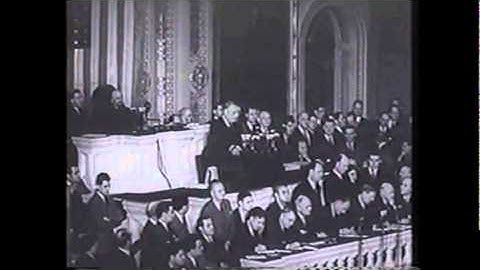December 7th, 1941 is a day changed the lives of all Americans. It is the day Japan deliberately attacked the U.S. naval base at Pearl Harbor, Hawaii killing many U.S. soldiers and destroying a lot of the U.S. naval fleet. This day which turned the tide of World War II, up until this point the U.S. had not chosen to intervene in the conflict overseas, but Japan’s attack had given the U.S. a reason to enter the fight. This speech given by President Franklin D. Roosevelt on December 8th, 1941 was his own passionate plea to the U.S. government and people to support the U.S. entering the war and fighting back against the tyranny occurring overseas. President Franklin D. Roosevelt effectively appeals to the emotions of the U.S. population by establishing trust with his audience through the use of emotional diction, and repetition which allow him to rally support for the war effort. Roosevelt impassions support for the war effort through his use of emotional diction through his declaration of war. He uses certain phrases to alienate the Japanese from the American people and show them as an enemy of the American people.Throughout his speech he uses phrases like “this form of…show more content… Show The thirty-second President of the United States, Franklin D. Roosevelt in his speech, Pearl Harbor on December 8, 1941, defines the brutal attacks by the Japanese. Roosevelt's purpose is to persuade Americans to join in the war effort and come together as a country. He adopts a resentful, patriotic tone in order to thoroughly bring attention to the recent attack and the course of action this entails. Roosevelt initiates his speech by describing the attack on Pearl Harbor the previous day and acknowledging the everlasting effect it will put on the country. He appeals to the emotional side of the audience using pathos by announcing that “this is a day that will live in infamy” (1) and that the United States was “suddenly and deliberately attacked by naval and air forces of the Empire of Japan” (1-2). This gives his audience a sense of security and relief as this implies that the United States would have stopped the attack if knowledge was present. Furthering the security, he states that he wants to unify the nation and “take all measures” in order to maintain defense and protection.…show more content… Nearly everyone has heard the words, “Yesterday, December 7th, 1941—a date which will live in infamy—the United States of America was suddenly and deliberately attacked.” These words, delivered by President Franklin Delano Roosevelt, are but a small piece of an elaborate example of a well-executed rhetorical speech. He used rhetorical devices and strategies such as anaphora, repetition, and amplification, in order to achieve his purpose of informing the people of the United States of the attack on Pearl Harbor the day before, to persuade the people to support the war effort, and to remember those innocent lives lost. A major rhetorical choice President Roosevelt incorporated into his moving speech was anaphora. After he explained the country’s relationship with Japan before the attack, and after he explained the devastating results of the attack, he starts to list off in a very structured order the other countries Japan chose to attack, using almost a formulaic approach: “Last night, Japanese forces attacked…” The reason he chooses to repeat the same structured phrases repeatedly is to grab the attention of the audience and to make them feel outraged. It shows who…show more content… What rhetorical device is used in the Day of Infamy speech?Roosevelt wanted everybody to know that Japan had been planning this attack for many months, further enraging American citizens. One rhetorical device that he uses throughout his speech is anaphora. President Roosevelt uses the repetition of one or more words at the head of consecutive phrases a couple of times.
Which rhetorical device does Roosevelt use in this passage?Which statement best summarizes the rhetorical technique Roosevelt uses to persuade her audience? Roosevelt uses loaded language to provoke intense emotions in audience members.
What rhetorical devices are used in Pearl Harbor Address to the Nation?Franklin Roosevelt uses pathos, ethos and logos all throughout his speech. “December 7th 1941- A date that will live in infamy.” This quote will forever be in the minds of Americans. The bombing of the Pearl Harbor is an event no one can forget and neither is Franklin Roosevelt's speech.
How does FDR use pathos in his Pearl Harbor speech?He appeals to the emotional side of the audience using pathos by announcing that “this is a day that will live in infamy” (1) and that the United States was “suddenly and deliberately attacked by naval and air forces of the Empire of Japan” (1-2).
|

Related Posts
LATEST NEWS
Populer
About

Copyright © 2024 ShotOnMac Inc.




























